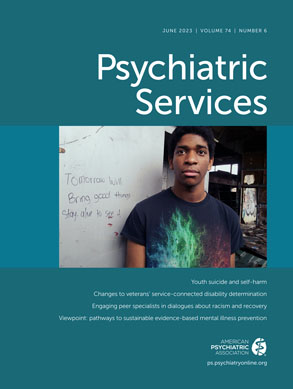TO THE EDITOR: Firearms and poisoning, often by medication overdose, account for most suicide deaths among the general population and U.S. veterans (
1). Lethal means counseling (LMC) is an evidence-based intervention in which clinicians encourage patients to limit their access to lethal means of suicide (e.g., firearms, medications), but only 30%–60% of individuals change their firearm or medication storage practices after receiving LMC (
2,
3). Because financial incentives have been shown to motivate behavior change (
4), we examined the acceptability and feasibility of using such incentives to increase safe storage of firearms and medications following LMC among veterans at risk for suicide.
We fielded a survey to veterans who had reported suicidal ideation in the preceding 6 months (on the Columbia–Suicide Severity Rating Scale [
5]) and to mental health clinicians from outpatient behavioral health settings in the Philadelphia Veterans Affairs Medical Center from September 2020 to September 2021. Surveys assessed perceptions of interventions utilizing financial incentives to motivate secure firearm or medication storage. Ratings ranged from 1, completely disagree, to 5, completely agree, where 3=neither agree nor disagree. A predetermined cutoff of >3 indicated acceptability. Veterans were recruited via mailed letters, and they completed surveys, including assessment of suicidal ideation, by phone. Clinicians completed surveys anonymously online after e-mail recruitment.
Eighty-five of 467 veterans responded (18% response rate). Their mean±SD age was 50.4±14.9; 16% (N=14) were women, 49% (N=42) Black, 27% (N=23) White, 12% (N=10) Latinx, and 12% (N=10) multiracial or other. About a third (32%, N=27) reported current access to a firearm (62% [N=53] previously had access), and 65% (N=55) reported current access to medications that could be toxic. Sixty of 300 clinicians participated (20% response rate); 45% (N=27) were psychologists, 25% (N=15) psychiatrists, 12% (N=7) social workers, 10% (N=6) nurses, 8% (N=5) other clinicians; years of experience=16.1±12.2.
Veterans indicated that they would find it acceptable to receive a gift card for completing a brief training about secure storage options for firearms (3.64±1.41) or medications (3.89±1.35), or for temporarily storing firearms outside of the home (3.98±1.36), unloading and locking firearms at home (3.73±1.53), safely disposing of unneeded medications (4.43±1.00), or locking or removing from the home medications not needed during the upcoming few days (3.93±1.36). Results from a repeated-measures analysis of variance showed that disposing of unneeded medications was considered more acceptable than the other options (F=5.02, df=5 and 415, p<0.001).
Veterans stated that a $20–$30 gift card would motivate them to engage in safe storage, although values ranged widely (to complete a training about storage options, median=$20, interquartile range [IQR]=$20, range=$1–$100; store firearms more safely, median=$30, IQR=$30, range=$1–$2,500; store medications more safely, median=$30, IQR=$30, range=$1–$5,000).
Veterans indicated willingness to confirm changes to their firearm or medication storage with clinicians by telephone (4.37±1.17), providing a picture of the storage facility or locking device (4.14±1.32), or providing a receipt from a storage facility or a key to a locking device (3.99±1.38). Veterans were less willing to have clinicians confirm changes by communicating with their family member or trusted friend (2.19±1.56, F=55.40, df=3 and 246, p<001).
Clinicians indicated that providing veterans with incentives was acceptable and feasible (rated separately) for completing a brief training offering information about storage options for firearms and medications (4.15–4.25±0.77–0.78), storing firearms more safely (3.63–3.68±1.05–1.15), or storing medications more safely (3.72±1.04–1.08). Completing a brief training was rated as more acceptable and feasible than the other options (F=12.90–15.47, df=2 and 118, p<0.001).
Additional strategies are needed to promote secure firearm and medication storage among individuals at risk of suicide. Findings provide support for further testing the incorporation of financial incentives into clinical interventions to encourage safety behaviors. Limitations of the study include a relatively small sample size recruited from one urban medical center and low response rates.

